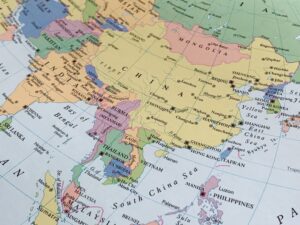Here’s How Countries Are Retaliating Against Trump’s Tariffs
In response to the Donald Trump administration’s second-term tariffs, Canada, China, Mexico, and the European Union (EU)—the United States’ largest trade partners—have announced or threatened retaliatory tariffs.
How do retaliatory tariffs work?
A tariff is a tax on foreign-made goods, which makes them more expensive to import. To get a better idea of how retaliatory tariffs could affect the United States, let’s look at what happened to American soybean farmers during Trump’s first term. Soybeans are the United States’ largest agricultural export to China.
In 2017, U.S. soybean exports to China totaled $12 billion, near an all-time high. Then in 2018, the United States placed tariffs on $34 billion worth of Chinese non-agricultural goods, and China retaliated with tariffs on U.S. soybeans and other products. Soybean exports to China plummeted, with U.S. farmers suffering substantial losses.
U.S. farmers’ losses were Brazilian farmers’ gains. Brazil, the world’s leading soybean producer, increased soybean exports to China and has remained its top supplier.
U.S. soybean exports to China recovered after the two countries signed a trade deal in 2020 but have declined somewhat in recent years as China has sought to become less reliant on imported soy.
From 2018 to 2019, U.S. farmers suffered $26 billion in losses due to China’s retaliatory tariffs. In response, the Trump administration provided $28 billion in bailouts to farmers across the two years…
…How could these retaliatory tariffs hurt the United States?
U.S. exports, specifically from the agriculture and livestock sectors, will decline in the short term as trade partners reduce their imports. U.S. producers will suffer from decreased revenue—as U.S. soybean farmers did during the 2018–19 trade war—while other countries will seek to fill the gap left by the United States. Soybean farmers have still not fully regained their market share of soybean exports to China.
Retaliatory tariffs could also result in an escalation of existing U.S. tariffs, hurting consumers as businesses pass on the costs of tariffs in the form of higher prices. The average U.S. household is already expected to face a cost increase of more than $1,200 per year as a result of existing U.S. tariffs. The imposition of retaliatory tariffs also raises other concerns, including the potential effects on the U.S. stock market and allies’ declining trust in U.S. economic leadership.
03/21/2025 | Christopher Shim & Will Merrow | Council on Foreign Relations
Brussels Hold’em: European Cards Against Trumpian Coercion
At the card table
“The European Union”, posted Donald Trump on his Truth Social account on March 13th, is “one of the most hostile and abusive taxing and tariffing authorities in the world”. For good measure, the US president added that the EU “was formed for the sole purpose of taking advantage of the United States”. The broadside was just the latest reminder that his administration’s trade wars against Canada, China and Mexico are heading Europe’s way, too. Already its 25% levy on steel and aluminium imports has hit the EU. At the time of writing, there appears to be a significant chance of Trump going far beyond these with sweeping multi-sectoral tariffs.
This is part of a wider story. The second Trump administration has challenged Europe’s territorial sovereignty (by threatening to annex Greenland), its digital model (by attacking its technology regulations), and its traditional political party systems (by courting radical European political forces). The president’s approach to America’s supposed allies on the continent evokes less a sober “strategic rebalancing” than the Ming dynasty’s tributary system, with European leaders expected to kowtow to the emperor in Washington. Trump also appears inclined to pressure Ukraine and its European backers into a peace deal favourable to Russia, and to withdraw significant parts of America’s security commitments on the continent.
The president has implicitly revealed why he thinks he can push Europe around like this. In a comment during his hectoring encounter with Volodymyr Zelensky in the White House on February 28th, Trump told his Ukrainian counterpart: “You don’t have the cards.” Cards are Trump’s euphemism for power and leverage. And to the extent that the American president is capable of threatening Europe across a series of fronts, this is a function of the cards he holds and his willingness to play them aggressively. In other words: Trump seeks to exploit Europe’s economic, technological, political and security vulnerabilities for coercive ends.
Europeans need to learn quickly how to play cards. They must assess the hand they have—Europe’s own sources of leverage over Trump and Trump’s America—and how to strengthen that hand. They must develop a clear and realistic plan of what they want to achieve in the transatlantic game of poker that is likely only just beginning. Where do they want to remain aligned with the US? Where do they want to rebalance the relationship? And where do they want to break from America? Then, Europeans will need to play their hand cannily in pursuit of those ends.
The first step in this process is to review that European hand of cards, what it would mean to play them and how Europeans should proceed with such decision making. Providing that review is the purpose of this policy brief.
Read the Full Policy Brief Here
03/20/2025 | Tobias Gehrke | European Council on Foreign Relations
How U.S. Tariffs on China Might Bolster Other Asian Economies
Trump has pledged far-reaching tariffs on Chinese imports, promising upwards of 60 percent on its goods. He has falsely claimed that these tariffs would punish Chinese manufacturing, but in reality, tariffs are often felt by the consumer.
Businesses and individual consumers are already stockpiling and preparing for increased prices, but once these tariffs are underway, where will manufacturing go? Many Chinese businesses are turning to neighboring regions. They now stand to gain major economic advantages if President Trump’s promised tariffs are implemented.
Tariffs are Taxes
While Trump has often said that tariffs are paid by the foreign manufacturer, that is not the case. A tariff is simply a tax on goods manufactured abroad. To simplify, under Trump’s plan, a Chinese product priced at $100 would face a 60 percent tariff upon arrival at the U.S. border. This means the American company receiving the product pays $60 to the U.S. Treasury. Thus, China receives $100 for the product, the U.S. government gets $60 for the tariff, and the business pays $160 total.
Companies then have a choice—they can pay the cost of the tariff and keep prices for consumers the same, increase the price by a percentage of the tariff to make some of the money back, or increase the price enough to cover the entire cost of the tariff. More often than not, they increase the cost to cover part, if not all, of the tariff.
In addition to the unintended consequences Trump’s tariffs will have on domestic consumers, his policies may also impact the economies of countries surrounding China. As American companies weigh their options for domestic or foreign manufacturing, Vietnam, Malaysia, and Kazakhstan stand to gain significantly if further tariffs are imposed on China.
The Impact on China and Surrounding Countries
Beijing’s response to trade shocks has been bolstered in recent years by implementing proportionate tariff increases and building relationships with surrounding nations. While the Chinese government tries to mitigate any potential impacts of the tariffs, many Chinese companies seek to set up shop elsewhere. This could have the intended consequence Trump is ultimately hoping for: to weaken China’s economy. But with Chinese businesses hoping to move away, countries like Vietnam, Malaysia, and Kazakhstan have a lot to gain by welcoming them with open arms.
Vietnam seems the most likely relocation for Chinese business given their positive trade relations with the U.S. The U.S.-Vietnam commercial relationship has flourished since the normalization of ties in the mid-1990s, making the U.S. Vietnam’s largest export market and a key source of foreign investment. Economic reforms (Doi Moi, in Vietnam) and Vietnam’s integration into global markets, marked by its entry into the World Trade Organization (WTO) in 2007, have driven remarkable progress—bilateral trade has surged from $2.9 billion in 2002 to over $139 billion in 2022. Vietnam is a rising star among Asia’s economies as it benefits from shifting global supply chains. It also stands as a growing market for U.S. agricultural exports, solidifying its role in regional trade and investment opportunities. Vietnam’s manufacturing wing and Chinese businesses have a lot to gain from these transitions.
03/25/2025 | Tatyana Masters | The International Affairs Review
TDM Insight: Vietnam Boosts Imports from China
Vietnam Pivots Back to Asia
Vietnam, one of the world’s most dynamic economies, now faces one of its most important challenges of this century as it faces protectionist headwinds and tepid consumer economies in the U.S. and Europe.
So far, its formidable export-based economy has seemed up to the task. In 2024, overall exports rose 14.3% year-to-year to $405.5 billion. The part of that from foreign direct investment increased 12.4% to $289.2 billion.
Vietnam’s coping strategy, according to an analysis by Trade Data Monitor, has been to turn more toward its prosperous ASEAN partners and China. In 2024, Vietnam increased imports from China a whopping 30.2% to $144 billion.
After the first Trump administration imposed hefty tariffs on Chinese imports in 2018, U.S. and Europe-based consumer goods firms moved or shifted parts of their manufacturing supply chains to Vietnam. It was a boon for the formerly war-torn nation, which promptly build a network of new economic zones, deep-water ports, rail lines and roads. After the 2018 duties, Vietnam’s gross domestic product grew by around 8% a year. In 2024, it expanded by 7.1%. A modern economic export miracle.
According to U.S. trade statistics, in 2024 Vietnam had the third biggest trade surplus ($123.5 billion) with the U.S., after only China ($295.4 billion), Mexico ($171.8 billion), and followed by Ireland ($86.7 billion) and Germany ($84.8 billion).
Now as the U.S. faces protectionist sentiment and economic uncertainty, Vietnam must prepare for an adjustment, and it will be essential to diversify export markets. An analysis by TDM suggests that Vietnam possesses the capacity to find new markets for its exports and diversify fruitfully.
The Asian Connection
Vietnam is tightly networked with its Asian neighbors. Seven of the country’s top ten sources of imports are Asian: China, South Korea, the U.S., Japan, Taiwan, Thailand, Indonesia, Malaysia, Australia, and Kuwait.
In 2024, shipments from South Korea nudged up 6.5% to $55.9 billion. By comparison, purchases from the U.S. rose 9.3% to $15.1 billion. Surprisingly, Japan is still the fourth biggest supplier of goods to Vietnam, although it is slipping. In 2024, Vietnam imported $21.6 billion from Japan, down 0.2% compared to 2023. Almost all of Vietnam’s imports from Kuwait were energy-related. In 2024, Vietnam shipped in $7.3 billion, up 23.3% over 2024, from the Middle Eastern nation.
But China was not yet Vietnam’s biggest export market in 2024. That would be the U.S. Vietnam shipped $119.5 billon of goods to the U.S. in 2024, up 23.2% from 2023. China was second, buying $61.2 billion worth of goods, flat compared to 2023. Vietnam’s next biggest exports markets were South Korea, Japan, the Netherlands, Singapore, India, the UK, Germany, and Thailand.
03/28/2025 | John W. Miller | Trade Data Monitor
WITA – We put the community in trade community.
Information about upcoming WITA and trade community events





